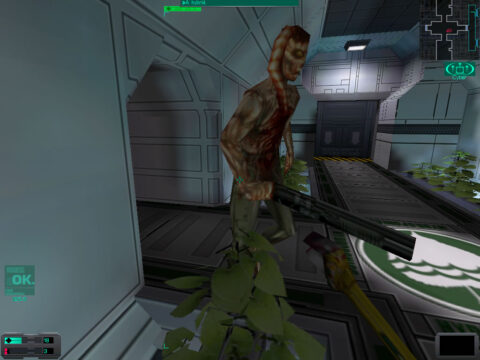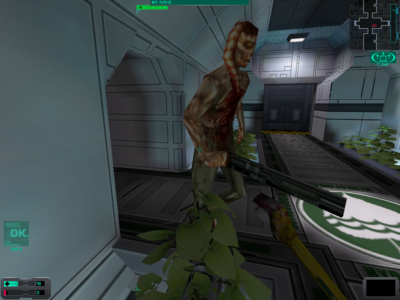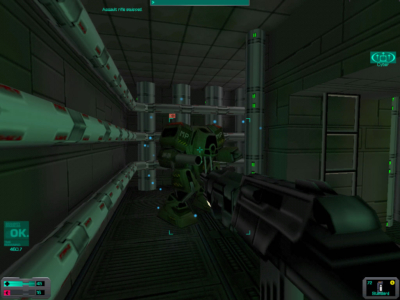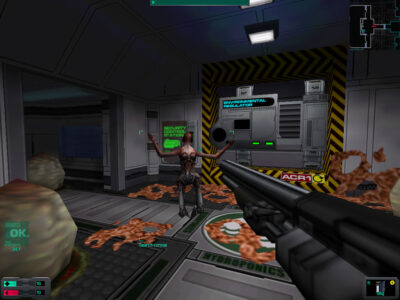
System Shock 2
Written by: Stoo
Date posted: February 22, 2002
- Genre: RPG
- Developed by: Irrational Games, Looking Glass Studios
- Published by: Electronic Arts
- Year released: 1999
- Our score: 10
In 1994 Looking Glass Studios brought us System Shock, a game dubbed “the Thinking Man’s Doom” in some circles. Well, by PC Zone anyway (a mag that inspired both of us in our youths). Where Doom was about hectic running and blasting, Shock was a slower-paced title with more emphasis on plot and atmosphere. It also happened to boast a rather advanced 3D engine for the day, with such features as slopes and looking up and down. It never gained the success of iD’s title, but still managed critical acclaim and respect from discerning gamers. Where by discerning I snobbishly mean “people like me”. I remember being quite keen for a sequel, even to the extent of mailing Looking Glass themselves to ask about the possibility. Around 1997ish, their answer was “looks unlikely”. Fortunately tho that sequel did indeed come about a few years later, a joint effort with Irrational Games.
To give a brief overview, System Shock 2 is a hybrid of first-person shooter, and roleplaying game. You move around, shoot things and interact with the world just like an FPS. However, a system of skills and vital statistics determines how powerful you are, what actions you can take and what weapons you have access to. Really, if RPGs aren’t normally your thing, don’t immediately discount this as it’s still some way removed from bearded dungeon-crawling. Meanwhile, powering all this is Looking Glass’ Dark engine, also seen in the Thief games.
The game begins with the character-creation process, done in engine and represented as your character reporting to a military recruiting station. You’re then posted as a lowly soldier to the Von Braun, the world’s first faster-than-light spacecraft, on her maiden voyage. It’s sent by Tri-Optimum, the corporation who’s Citadel station was the scene of a terrible disaster in the first game. Which isn’t promising. For reasons initially unknown, rather than being an active part of the crew, you’re stuck in aliens-style cryosleep for several months. When you wake up, the situation is all very familiar to anyone who played the first Shock. The crew are all dead, or turned into hideous half-human monsters. Worse, the ship’s own security systems are shooting at anything human. You have only a few resources, very limited knowledge of whatever the hell is going on here. You’re beyond help, and rather hopelessly outmatched. And now whatever’s out there has noticed you. Welcome back to System Shock!
You can’t just hide in a closet and wimper, tho, even if it seems a tempting option sometimes. Being a soldier and the last man standing, you’ve got to try and do something. So, grabbing a handful of medical patches, a wrench and a pistol , you set out to explore the innards of the Von Braun. The first enemies you meet are the hybrids, former crewmen taken over by a parasitic worm. You’ll hear them padding along the corridors, moaning to themselves and muttering things like “you cannot hide forever” and “your song is not ours”. Then when they catch sight of you they scream with rage and beg you to kill them even as they try to smash your head in. Very creepy, and it gets worse. You might spot a hybrid wandering around in the next room and go instantly onto the defensive, covering the entrance with your shotgun. Then suddenly you hear a screech, realise to your horror that one of the horrifically mutilated cyborg midwives has caught you off guard. With a big girly yelp you spin around and pump shells into everything in front of you, desperately hoping that the cyborg goes down before you. Even if you win the encounter, you may likely be much the worse for wear, and it’s a long way to a healing machine. Oh and if you’re unlucky, your gun is now broken. Good luck surviving.
You might hear shock described as a “scary” game, and like the example above explains you can certainly get some OH JESUS!!! moments. However, it’s really not just about “boo! Monster jumps out at you!”. Beyond that, it works as as psychological horror. Without wanting to give too much away your main enemy is essentially a horrible perversion of life, corrupting peoples bodies and using them as material to build its servants. Without even having the mercy to destroy their minds first. The emotions provoked are thus often disgust and pity, as well as fear. Not only are the mutants pretty awful, but those midwives are amongst the most disturbing enemies I’ve yet seen in a game, mangled bits of a young woman attached to a metal frame and humming lullabies to themselves. When not trying to claw your head off.
Much of the backstory which sets up the situation you’re in, is told through audio logs recorded by the crew, that you find scattered about the ship. The dates are scattered across the months preceding the events of the game, and you don’t get them in any kind of order. So slowly a picture forms of what’s being going on while you were asleep. Some relate the start of the mission when the situation was pretty normal. Others tell us how the disaster occured, with a rising note of puzzlement leading to fear and panic, and finally to outright chaos aboard the ship. There’s one rather poignant story of a woman who’d never even touched a gun before, picking up a rifle in a doomed last stand. Worse, there are accounts of how the paranoid crew turned on each other, resulting in further tragedy, and even some from people taken over by the Many. Sitting in a quiet hiding place listening to the story of the Von Braun’s doomed mission, and the brief tales of fear, despair and grim defiance, can be quite moving. So a marvellous job is done of setting the scene, and making you the player actually care about what’s happened here – as the people who recorded the logs are now the bodies littering the corridors. Or the cyborgs and mutants coming to kill you.
The game takes places across several decks of the massive ship, each of which has a designated function. Importantly the environments do genuinely look like they have some purpose – places like research labs, living quarters and engine rooms. It’s is the difference between a bunch of corridors for shooting monsters in, and a convincing, immersive environment. You can let yourself believe this was once a place where people lived and worked, before a disaster hit. So a plush casino is now a cyborg-infested deathtrap. Down in the labs, lab-experiment monkeys run screeching after you. In the cargo bay politely-spoken protocol robots break out of their boxes, shuffle at you from out of the gloom, then explode in your face. The dated graphics engine still does a sound enough job of creating the architecture, and the soundtrack adds to the tension. So overall it’s one of the creepiest, most ominous-feeling environments I’ve come across in a game. Something about it all weighs down on you, making you tread fearfully instead of dashing about in an heroic manner.
As you progress you gain in strength, and find some bigger guns. So the sense of immediate vulnerability fades a little, and you feel a little more in control of the situation. Still that sense of tension pervades, of one man in an utterly hostile environment against a truly terrible foe. Worse, the enemy has a collective voice that speaks in your head. Utterly untouchable, coming from everywhere and nowhere, it cajoles and taunts you, asks what you can possibly do to stop it, and entreats you to join with it. Oh, and they’re not the only problem out there. SHODAN, the crazed artificial intelligence from the original game, has a part to play also (that might be a spoiler but to be fair, her face is plastered all over the box). She retains her cold mechanical hatred for all things living, and rather fancies herself a goddess. So that’s just going to make your nightmare situation even worse. Good luck!
Moving on to the RPG bits, as you meet objectives you’re granted “cyber-modules” which can be traded in at special terminals to upgrade your character’s sklls. They’re divided into three sets, one being weapons. There’s a wide range on offer, coming in four categories each with its corresponding required skills. So for example in “standard” weapons you have a pistol, shotgun and assault rifle, with the other categories being heavy, energy (think lasers) and weirdy exotic gear. A nice touch is that many weapons have multiple ammunition types for different types of target, or changeable powers settings. Unfortunately they’re not especially well balanced; the assault rifle is powerful enough such that, once you can wield it, the other weapons become redundant. Many weapons in the other categories are either too specialised, underpowered or just fiddly to use.
The “navy” skills meanwhile are technical in nature, and represent interactions with items you find on the Von Braun. The most useful is hacking, which lets you switch off the security cameras around the base that summon reinforcements. Also you can take the snack-vending machines, which are kind of like Star Trek replicators and convert them to sell ammo clips. Best of all is taking over the defensive gun turrets, and letting them take care of monsters for you. Just like in the first game, the hacking is done with a little mini-game on your interface. A bunch of other skills relate to repairing and maintaining weapons – which degrade in quality over time and eventually break. Finally research lets you study bits of dead enemy to gain damage bonuses against them, which is both macabre and cool, and is needed for access to the exotic weaponry.
Finally you have psionic powers. Which, as most sci-fi fans will realise, is just a more futuristic way of saying “magic”. If you’re groaning inwardly though then bear with me; only a few powers are wizards-fireball attacks. Many of the other powers are simply useful utilities, like pulling items through the air jedi-style, or protection from radiation. Later on, some of the higher-level ones let you turn invisible and making enemies turn on their comrades. Making hulking, fearsome monsters tear chunks out of each other, is a rather satisfying alternative to going in guns blazing.
So while the weaponry really could have done with reworking, the overall system works pretty well. The two main choices here are a gun-toting type, or as a more subtle psionic agent. In my experience the former has an easier time early on, but the latter rules the late stages. As for the techy stuff, it doesn’t really sustain a character by itself, but saving some points for tech skills is a viable option that can often make life easier. Looking back I sort of wish they’d implemented a comprehensive stealth system – it seems an obvious choice given the game’s relationship with Thief, and the suitability of the environment. Still there’s definitely enough here to keep you going for a couple of runs through.
Now, at the risk of this review being formulaic, I’d better add an obligatory “what about the graphics?” paragraph. Well, yes, it’s rather dated, although if you’re still reading I assume you can live with that. For reproducing the warren-like innards of the Von Braun, it’s quite adequate for the task. The bad news is that character models in the Dark Engine tended to be rather low-poly and ugly, even by 2000 standards. Fortunately though you don’t run into too many actual humans, who suffer the most from this. Meanwhile, critters like cyborgs and hybrids are supposed to be pretty twisted anyhow, so the effect isn’t quite so bad. There are also a few fan projects out there seeking to update the models, for the greater muscle of modern hardware.
By now it should be pretty obvious that I was very impressed with SS2; so in the interest of being Fair and Balanced I’ll relate a couple more weaknesses. For one, like so many games it falters a but in the last stages. To describe them in any detail would give away too much of the story, but suffice to say their premise is a bit unconvincing. If you recall how some thought Halfe-Life went a little crazy towards the end, it’s a similar issue in Shock2. Here’s another complaint: you don’t have any means of lighting up dark areas. This is a bit of a poor show, seeing as the original Shock offered you both a lantern and night-vision.
All in all Shock 2 is a true classic – play it in the dark with headphones for best effect, just make sure you remember to get to bed on time. It’s utterly gripping, with atmosphere by the bucketload, and a well crafted mix of action and apprehension. Meanwhile blending in the RPG aspects maybe make it a little slow to start off with, but it’s worth it for the depth and replay factor. It’s a worthwhile idea that would later be used in a couple of other classics, Deus Ex and VtM: Bloodlines. I sometimes debate whether this small hybrid subgenre represents an improvement on the first-person shooter, or if it’s a branch that should be assessed separately, but for now i’ll just say I definitely enjoyed this over even Half-Life. So I could rattle on for another few paragraphs about how engrossing and creepy a gaming experience is but you probably get the idea. So let’s just leave it here with me saying it comes with our top recommendations.





 Posts
Posts